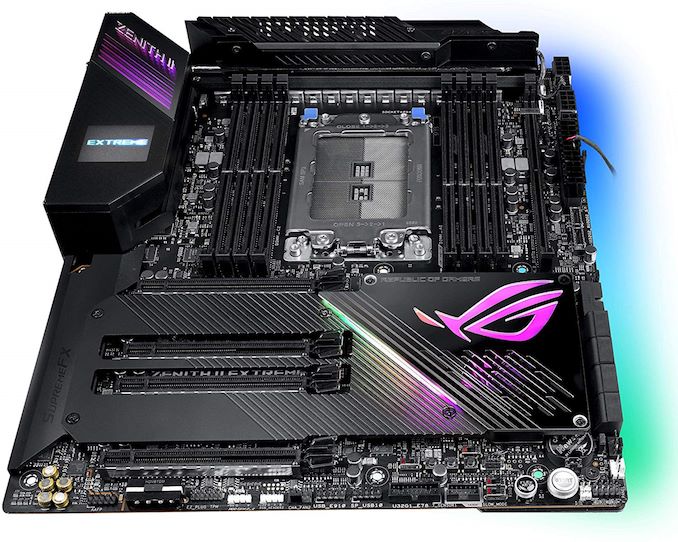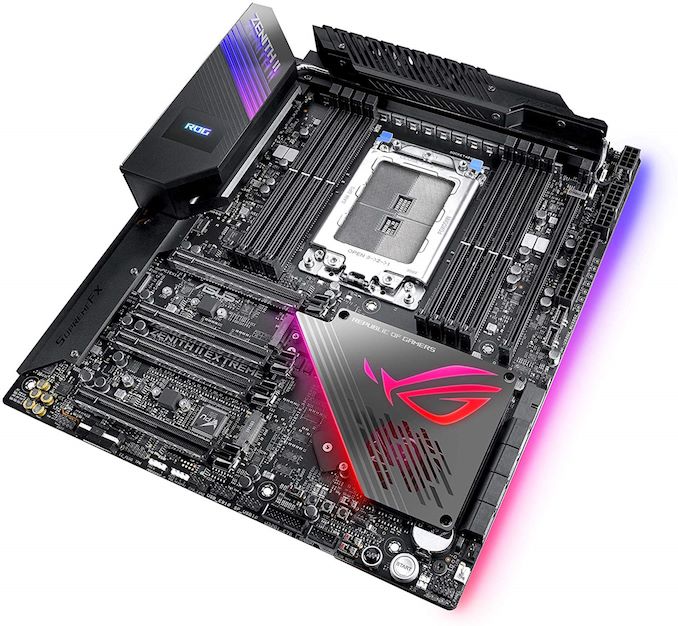The ASUS ROG Zenith II Extreme TRX40 Motherboard Review: The Second Coming
by Gavin Bonshor on December 23, 2019 9:00 AM ESTASUS ROG Zenith II Extreme Conclusion
The ASUS ROG Zenith II Extreme has a price tag of $850 and sits at the top of the TRX40 product stack from ASUS. With the addition of the two new AMD Ryzen Threadripper 3970X and 3960X, and the 3990X with 64-cores expected next year, the quality of the boards needs to follow suit to match users expectations from a HEDT platform such as TRX40. The second iteration of the ROG Zenith Extreme models brings a few new things to the plate for users to utilize including a nifty LiveDash 1.7" OLED display and all of the benefits of the TRX40 chipset including PCIe 4.0, and the diversity of how vendors can use the spare PCIe lanes to its advantage.
Touching on the core feature set, the ASUS ROG Zenith II Extreme has a packed E-ATX PCB with plenty of premium controllers and features to get the most out of the high-end system. These include a solid array of networking options including a pair of Ethernet controllers consisting of an Aquantia AQC107 10 gigabit Ethernet port and Intel I211-AT Gigabit controller, as well as an Intel AX200 Wi-Fi 6 wireless interface which also adds BT 5.0 connectivity. For storage devices, there are two front-mounted PCIe 4.0 x4 M.2 slots with heatsinks, a single PCIe 4.0 x4 M.2 slot on the rear, and users can add a further two PCIe 4.0 x4 M.2 slots via the included ROG DIMM.2 module in the accessories bundle. Also present is eight SATA ports with four controlled from the TRX40 chipset with support for RAID 0, 1, and 10 arrays, and four from a pair of ASMedia SATA controllers.
Focusing on the design, ASUS has gone with an all-aluminium armor which covers the area around the four full-length PCIe 4.0 slots which operate at x16/x8/x16/x8 and amalgamates the actively cooled chipset set heatsink into its design. The PCIe cover stretches around to the large aluminium rear panel cover which includes integrated RGB LEDs, as well as the chipset heatsink and the right-hand underside of the board. The rear panel also houses the LiveDash 1.7" OLED color screen which users can use as a debugger for checking POST errors or upload custom GIFs to make that style even more unique. The contrasting black aluminium, combined with the RGB and the grey on the chipset heatsink makes the design pop and looks like a true flagship ROG board we've come to expect.
The performance in our testing of the ASUS ROG Zenith II Extreme shows that it's very competitive with what other manufacturers are offering on the TRX40 chipset, with a notable positive in our non-UEFI POST time test. Computational and gaming performance are where expected with our Threadripper 3970X processor. Other areas where the ROG Zenith II Extreme excelled was in our power delivery thermal testing, with the best temperatures from all the TRX40 models we have tested so far. Overclocking performance is also solid with a maximum stable overclock across all 32-cores on our Threadripper 3970X at 4.3 GHZ with 1.35 V on the CPU VCore. Across our range of manual overclock testing, VDroop was consistent at lower frequencies and constantly undervolted at full-load which does reduce temperatures and overall power consumption, so it's favorable to have. The 16-phase power delivery is solid with ASUS's optimized teamed power stages for better transient response under full-load, and it's highly capable of doing enthusiast-level overclocks with capable CPU coolers. With its LN2 mode and dual BIOS, as well as the overclockers toolkit on the PCB, it is likely to be used for the more extreme cooling methods.
Another thing ASUS has focused on with its flagship TRX40 model is connectivity. There is five USB 3.1 G2 Type-A, one USB 3.1 G2 Type-C, four USB 3.1 G1 Type-A, and one 20 Gbps USB 3.2 G2 Type-C ports. It's not quite Thunderbolt 3, but it's the next best thing. The audio includes a trio of codecs and DACs with a SupremeFX S1220 codec doing most of the grunt work with the five 3.5 mm audio jacks and S/PDIF optical output, with a Realtek ALC4050H HD audio codec bridging the gap between the S1220 through the USB 2.0 interface. An ESS Sabre ESS9018Q2C which is for the front panel audio completes the audio setup. The rear panel also includes a BIOS Flashback button, and a handily located Clear CMOS switch.
The ASUS ROG Zenith II Extreme has an MSRP of $850 and is one of two models at the price point. The ASUS model focuses on refining the previous Zenith model for the PCIe 4.0 TRX40 chipset and does so very well. Allowing users to use up to five PCIe 4.0 x4 M.2 drives simultaneously while supporting up to 256 GB of DDR4-4733 memory across its eight slots gives users a solid foundation to build a ridiculously powerful desktop system. AMD has re-invigorated the HEDT market with its Threadripper 3000 processors, with the madness set to continue next year when the Threadripper 3990X with 64-cores is unleashed; the ASUS ROG Zenith II Extreme is one such board that enthusiasts will be chomping at the bit to put Threadripper 3000 to full use.












22 Comments
View All Comments
mark625 - Monday, December 23, 2019 - link
"The ASUS ROG Zenith II Extreme is the predecessor of the previous generation of X399"Shouldn't it be the successor, and not the predecessor? Unless it also has a flux capacitor in there somewhere....
The_Assimilator - Tuesday, December 24, 2019 - link
It should be, but AnandTech should also do basic proofreading, and we know how that goes.Korguz - Tuesday, December 24, 2019 - link
then feel free to go some where else if it bothers you that much.flyingpants265 - Monday, January 6, 2020 - link
I guess we should never, ever, ever complain about anything, then.tech6 - Monday, December 23, 2019 - link
Why use the "Republic Of Gamers" moniker on something that clearly is not designed for gaming?Xyler94 - Monday, December 23, 2019 - link
ROG typically is for Asus's top end consumer products. Yes, I agree they should probably use something else for these super CPUs, but everyone knows Republic of Gamers as being top tier, so Asus... probably to save marketing costs, just use it.Slash3 - Monday, December 23, 2019 - link
The board also features a full assortment of overclocking options in the BIOS in addition to features such as dual BIOS, on-board power, reset, CMOS clear and safe boot buttons, RGB controls and good VRM cooling and componentry, etc. It's capable of gaming as well as workstation tasks, in keeping with the Threadripper's strange origins as a side project for power users.eek2121 - Monday, December 23, 2019 - link
People said that about the 1950X as well. Yet I game at 4k60 all day long (when I'm not doing other stuff that I purchased the processor for).zorxd - Monday, December 23, 2019 - link
it works just fine, but you just don't get as much performance as with a much cheaper CPU with less cores but higher frequency (better performance with 8 or less threads)GreenReaper - Monday, December 23, 2019 - link
Hoping to benefit from the goodwill associated with the Republic in Star Wars?